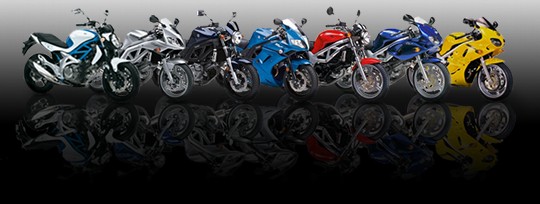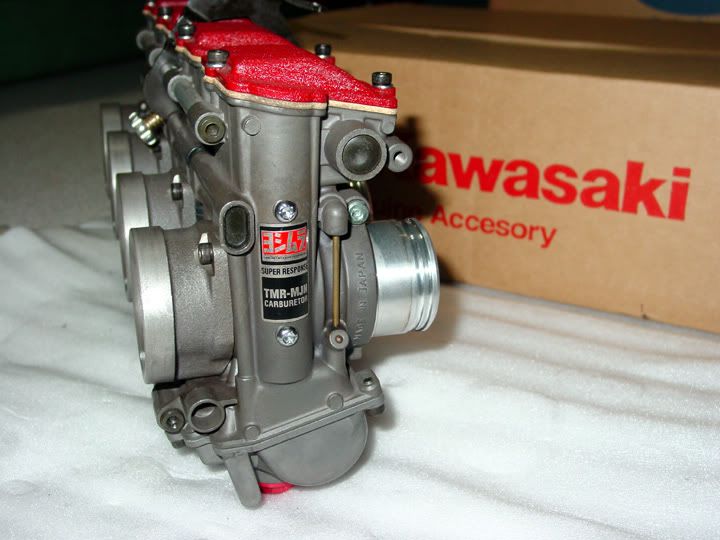 |
 |
| SV Talk, Tuning & Tweaking Discussion and chat on all topics and technical stuff related to the SV650 and SV1000 Need Help: Try Searching before posting |
 |
|
|
Thread Tools |
|
|
#11 |
|
No, I don't lend tools.
Mega Poster
Join Date: Jul 2003
Location: Skunk Works, Nth London
Posts: 8,680
|
I sincerely doubt this. Timing - at least for best torque at part throttle - must take account of load, historically was done by vacuum, (as Embee rightly points out), the modern equilavent is throttle position sensing.
__________________
If an SV650 has a flat tyre in the forest and no-one is there to blow it up, how long will it be 'til someone posts that the reg/rec is duff and the world will end unless a CBR unit is fitted? A little bit of knowledge = a dangerous thing. "a deathless anthem of nuclear-strength romantic angst" |
|
|

|
|
|
#12 |
|
Guest
Posts: n/a
|
sid, not sure what you doubt.
that its was originally put there for emissions? or that bikes with the tps by-passed wont run as well as those with? some members on here would appear disagree with that, on the basis of their experience reported on the old TPS thread. all it does - at least on carbed bikes like the zrx - is retard ignition timing at specific revs. I completely agree that regarding the SV, I can't be certain what the result of a bypass would be, that's why I was asking, but based on other machines it seems likely that its absence would merely result in a default CDI setting, and why that default setting would not be to run all revs at optimum advance seems hard to fathom. What I suspect is that in effect the TPS improves fuel consumption / emissions but compromises performance up to a certain point in the range. Kawasaki actually issued a ZRX map - in fact its a 3d graph with 3 axis ie revs, degree of timing, and percentage of throttle opening - to show how their TPS kicks in, I have a link if interested. Thing is, a strict interpretation of embees post would mean no carbed bike without a TPS could run as well as one with, something which tuners all over the world would take issue with. If ignition is set to optimum advance, it will do the job irrespective of load, although it may not be as fuel efficient as a TPS bike - which brings us back to emissions. Anyway, always good to have input irrespective of outcome, including me being wrong, and I appreciate that. Last edited by saintnick; 17-10-11 at 11:15 PM. |

|
|
|
#13 | |||||||
|
No, I don't lend tools.
Mega Poster
Join Date: Jul 2003
Location: Skunk Works, Nth London
Posts: 8,680
|
Quote:
No, it affects timing by taking account of engine load - which throttle position is a good indicator of. Quote:
Quote:
Emmisions and economy are not the same thing - you can burn a small amount of fuel badly, and by the same token you can burn a large amount of fuel very well. Quote:
Quote:
Quote:
Quote:
All said if you were constructing a bike for racing which didn't have a TPS there'd be little benefit in the bother of getting and setting up one, WOT is really all you'd be concentrating on, and as said above that's an area where the TPS has its least, if any, effect. But if you're constructing one. like an SV, that already has one there's no benefit in removing it - if it's working right that is, if not then by all means bin it. But there will be a negative effect, it may be an irrelevant effect if you're running a race bike where part throttle running isn't what you're concentrating on, but there will be an effect.
__________________
If an SV650 has a flat tyre in the forest and no-one is there to blow it up, how long will it be 'til someone posts that the reg/rec is duff and the world will end unless a CBR unit is fitted? A little bit of knowledge = a dangerous thing. "a deathless anthem of nuclear-strength romantic angst" |
|||||||
|
|

|
|
|
#14 |
|
Guest
Posts: n/a
|
Ta for that.
I think there maybe some confusion here between how the device works (no arguments from me on that score) and what it does in reality, which is where we part company. I think its functionality is limited, as previously described. At some point I'll try life without it for a while and report back, since a practical evaluation is the only answer - some members have already done this and reported their findings, which seem to be consistent with low rev retarding. I still maintain that the device would not be there if there was no emissions legislation: this is just one of many references. CDI: call it an ECU if you prefer, but the SV clearly does have an Ignitor which I assume is a conventional CDI unit. The SV service manual refers to it as a Digital Ignitor. There are certainly plenty of threads referring to it as a CDI on here. |

|
|
|
#15 |
|
Member
Mega Poster
Join Date: Jul 2003
Location: Warwickshire
Posts: 2,801
|
Steady on there. Sid
I guess what is being referred to is an ignition map, something like  What you see on the "front-right" face at around 1000mBar is the "full load" ignition advance curve. That's what traditional (i.e. old fashioned) bike engines ran with. It would be approximated with centrifugal weights and spring devices which could give perhaps 3 slopes versus speed, or fixed/slope/fixed type relationships. That would often allow a reasonable fit to the "optimum" ignition requirement for best torque at any speed with Wide Open Throttle (WOT). Car engines, where fuel economy was a more important consideration, were fitted with a vacuum sensing system to provide the extra advance needed in order to fit the other axis, the "load" or throttle opening at a given speed. A very convenient measure for this is the inlet manifold absolute pressure (MAP), and originally a vacuum capsule was used which pulled the points backplate round as the manifold vacuum increased at small throttle opening, thus advancing the ignition timing. This was traditionally considered an un-necessary complication for bike engines where no-one really cared much about fuel economy or part load running. Yes an engine will run on just a full load function, but it's wasting a lot of potential benefits. Light load needs more ignition advance because the burn is slower than at full load, the charge density is lower and generally charge motion is less, so flame speed reduces. Combustion can be considered in simple terms as 3 phases, the initiation where the spark gets a kernel of flame going (the first 5 or 10% of the total mass of charge), the main phase (10-90%), and the end phase (last 10%). It isn't a simple relationship because the 3 phases don't all respond to speed/load in the same way, but generally speaking light load (or EGR dilution, or weak mixtures) needs more advance becasue of slower flame speeds and slower initiation of burn. The mechanical systems were superceded by electronic systems, with programmed values for ignition advance against speed (using triggers) and load (often inlet MAP). MAP sensors work quite well with multi-cylinder manifolds, but for individual port runners (as on bikes) this gets less convenient due to pulsing, and correlating load to throttle position against speed enables a decent measure of load to be achieved. Note that "full load" is achieved at quite small throttle openings at low speed but wider openings as speed increases, so it has to be "mapped" against speed. Many cars use a "mass flow sensor" (principally for fuelling but also giving a load measure), which have significant advantages over both TPS and MAP sensing, but cost more and need careful installation conditions. I suspect what might be interpreted as "retarding the ignition" is the fact that an ECU can only calculate angle after a trigger point, it can't anticipate it, so all ignition calculations are a retard after a trigger point, more retard at full load, less at light load. Ignition trigger wheels or pulses often consist of a number of even pulses and an odd one, or something equivalent, so it can work out angular position and speed and then fire the ignition for each cylinder at appropriate times. The crank angle reference might be say 60deg BTDC, so all ignition values are retarded from that. Ignition advance does have an effect on emissions (HC/CO/NOx) and modern car engines use it to considerable effect, particularly when controlling NOx production, but I rather doubt it was used much for that reason on the last generation carb bike engines (don't know for sure, haven't been involved in the OE engineering of bike engines). Regulated emissions at that time weren't particularly demanding for bikes, and the shortcomings of carbs far outweigh the effects achievable with a few degrees of ignition. If anyone knows different for definite it'd be an interesting topic. HTH
__________________
"Artificial Intelligence is no match for natural stupidity" |
|
|

|
|
|
#16 |
|
No, I don't lend tools.
Mega Poster
Join Date: Jul 2003
Location: Skunk Works, Nth London
Posts: 8,680
|
See what I mean
CDI is something quite specific; capacitor discharge ignition. CDI doesn't mean computerised digital ignition or any of the other various things that I've heard corrupted from CDI. It's been written here on this very site approximately 78,000,000 times that SVs have CDI, that's still wrong though As a brief and almost criminally simplified explanation I wrote this.
__________________
If an SV650 has a flat tyre in the forest and no-one is there to blow it up, how long will it be 'til someone posts that the reg/rec is duff and the world will end unless a CBR unit is fitted? A little bit of knowledge = a dangerous thing. "a deathless anthem of nuclear-strength romantic angst" |
|
|

|
|
|
#17 |
|
Guest
Posts: n/a
|
Excellent info from contributors, and yup, I did know it was capacitor discharge....
There is no doubt that TPS usage has evolved massively - these days it seems to be involved in everything from kickdowns to traction control (and BMW anti knock systems). But even in early SV days some territories - like California - already had emissions legislation, and we were gearing up for the notorious Euro 3 directive. When you think about it quite a few emissions related bits and bobs had already appeared on bikes by the end of the nineties: ie air going back into the bike's zorst, header design, and.... the TPS. Cats were next. I worked on a dyno for a while, and I recall that while carbed bikes with an aftermarket ignition advancer did benefit slightly by comparison with same model bikes and OE ignition set up, setting the carbs up and optimising jetting for a decent A/F mixture through the range was by far the most important step. Carbs still have their fans, getting FI spot on for bikes has taken an awful lot of time, to the extent that riding with some decent well set up carbs can still surprise, crisp but oh so smooth... these Mikuni TMRs are nice, a favourite on big retros for road and race:  I've ridden some horrendously set up standard FI bikes: Fazers from a couple of years back, many KTMs - early 990 superdukes come to mind at once Ironically, it was because the Sv seemed a bit snatchy in an iffy FI way coming from a closed throttle that the thread started, and I haven't ruled out the possibility that the carbs are at the bottom of the issue. Last edited by saintnick; 19-10-11 at 12:18 AM. |

|
|
|
#18 |
|
Member
Mega Poster
Join Date: Jul 2003
Location: Doncaster, oop norf
Posts: 2,122
|
Goign back to something on page 1, Nick reckoned that removing the TPS would give most ignition advance. Add this to the fact it's an ex-JHS bike and they (at least used to) sell ignition advance Woodruff keys, I would reckon the smoother/better bottom end comes from ignition advance which adds a good jollop of bottom end torque while making almost no difference to the top end (so ideal for a Minitwin where bhp is the defining thing).
|
|
|

|
 |
|
|
 Similar Threads
Similar Threads
|
||||
| Thread | Thread Starter | Forum | Replies | Last Post |
| Throttle Position Sensor | hardhat_harry | Mini-Twins | 0 | 08-11-09 09:37 PM |
| Gear Position Sensor | Yarodia | SV Talk, Tuning & Tweaking | 33 | 04-05-09 07:19 PM |
| throttle position sensor | Bibio | SV Talk, Tuning & Tweaking | 9 | 20-10-08 02:49 AM |
| Pointy throttle position sensor | svdemon | Stuff Wanted | 9 | 02-09-08 07:50 PM |
| Throttle Position Sensor | tricky | SV Talk, Tuning & Tweaking | 10 | 08-06-06 07:16 PM |